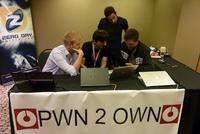-
New radar optimized for homeland security
A new radar is designed to provide an affordable, modular solution for border protection and coverage of wide areas, offering good detection capability of ground targets and aerial targets, specifically homeland security-relevant objects flying slow at very low level
-
-
Huawei tries to crack U.S. market again with U.S. Cellular deal
Chinese giant Huawei Technologies Co. recently announced that it was the finalist for a contract to build a fourth generation wireless network for U.S. Cellular Corp, the nation’s sixth largest wireless carrier; in response to the deal, U.S. lawmakers sent a letter to President Obama to permanently stop Huawei’s efforts to sell network infrastructure in the United States; in the past, lawmakers have vocally opposed Huawei’s attempts to enter the U.S. market fearing that the telecom giant would install equipment that contains bugs that would make it easier for China to steal information, shut down communications, or make networks easier to hack; Huawei is the world’s second largest telecom manufacturer
-
-
EMC acquires NetWitness to add to RSA
On Monday, EMC Corp. announced that it had acquired Virginia-based NetWitness Corporation, a firm that provides network security analysis solutions; EMC is one of the world’s largest information infrastructure solution firms and is the parent company of RSA, which specializes in security solutions for government agencies and corporations around the world; NetWitness will become a core element of RSA’s Advanced Security Management Solutions providing it with technology to detect and analyze threats in real-time; EMC’s acquisition of NetWitness comes after RSA recently revealed that hackers had infiltrated their networks and stolen sensitive information regarding its SecurID two factor authentication products
-
-
Spray-on explosives detector
A chemist at Oklahoma State University has developed a spray-on material that detects explosives made from peroxides and renders them harmless; the material is a type of ink that contains nanoparticles of a compound of molybdenum. The ink changes color, from dark blue to pale yellow or clear, in the presence of explosives
-
-
RSA explains how hackers stole critical SecurID data
Cyber security giant RSA detailed how hackers recently infiltrated its systems and stole critical data related to its SecurID two factor authentication products which are used by the Department of Defense, major banks, and other government agencies around the world; hackers used a “spear-phishing attack,” fake emails containing malicious code, to first gain access to its networks; once inside the network, hackers were able to target high-level RSA employees with access to sensitive information and copy their data; experts warn that these types of attacks primarily exploit people, so educating employees to not open these types emails that may contain malicious code is critical
-
-
China raises rare Earth elements production
China has about 30 percent of rare earths deposits but accounts for 97 percent of global production; the Ministry of Land and Resources said Thursday that this year’s production quota of rare earths will be 93,800 tons, an increase of about 5 percent over 2010
-
-
San Francisco to regulate private biological agent detectors
Some firms have begun selling building owners and companies untested devices designed to detect anthrax and other biological agents, but city officials are worried that these will generate false alarms; in San Francisco city officials estimate that responding to a false alarm generated by a biological agent detector could cost as much as $700,000; legislation has been introduced to regulate these devices; the bill would require those who have biological agent detectors to pay an annual fee and owners would also be fined as much as $10,000 for false alarms; if passed, owners would have ninety days to register with the city
-
-
U.S. industrial processes vulnerable to Stuxnet-like attack

Cyber security experts recently warned that U.S. manufacturing plants and critical infrastructure were vulnerable to a Stuxnet-like attack; industrial plants, transportation systems, electrical grids, and even nuclear plants could be crippled by new cyber weapons that target specialized control core processes; concern has spread after the Stuxnet virus targeted these systems and created physical damage; experts have likened Stuxnet to “the arrival of an F-35 into a World War I battlefield”
-
-
DigiSensory cameras predict crime before it happens
With DigiSensory Technologies’ sophisticated cameras and sensor systems, law enforcement agencies and transportation departments across the United States are now able to proactively monitor and respond to crimes or accidents as they unfold; the company’s Avista sensors process the images that its 3.2 megapixel high-resolution camera records in real time and can automatically detect when a crime is occurring; when it senses something it will alert law enforcement officials instantly; the sensors can also assist transportation departments in analyzing traffic patterns in real time; the system could allow officials to change one way streets, design real time traffic signals, and multiple speed limits to make traffic flow more smoothly
-
-
Businesses cannot defend against cyber attacks, expert says
In a recent testimony before Congress, a cyber security expert warned that the private sector in the United States has proven unable to defend the nation’s critical cyber infrastructure from attack; businesses own 85 percent of critical infrastructure and they have not invested in the skills or technology to secure it from cyber attack leaving the electrical grid, financial services, and other key elements vulnerable; foreign intelligence agencies, organized gangs, and corporate spies have successfully infiltrated banks, multinational corporations, and even government websites and stolen sensitive data; cyber security experts urged for greater government regulation to secure U.S. networks
-
-
Android and Windows 7 phone confound hackers in competition

Android smartphones and the Windows 7 phone foiled hackers at the recent Pwn2Own hacking competition, while the Apple iPhone and Blackberry were successfully broken into; the results do not necessarily mean that Android and Windows 7 phones are more secure; several factors determine the relative protection a device has against hackers including the security of the software itself and the amount of research that has already been conducted on the device’s weakness; observers were surprised to see the Android repel attacks, but were not shocked when the iPhone was hacked
-
-
Lockheed developing autonomous and covert rover
A surveillance robot aims to operate around humans without being detected by them; the machine uses a laser scanner to builds a 3D computer model of its surroundings and uses a set of acoustic sensors to distinguish the proximity and direction of footsteps
-
-
Alstom acquires CA company, seeks to enter U.S. smart grid market
French electrical grid manufacturer Alstom recently acquired Utility Integration Solutions, Inc. (UISOL) in its efforts to expand its smart grid control room capabilities and enter the U.S. market; UISOL specializes in demand response management systems, which are critical to the operation of smart grids; analysts believe that this could put Alstom in position to become an integrated systems provider for smart grids in the United States on par with ABB, Siemens, and General Electric
-
-
Northrop awarded $1.1 billion DHS contract
Northrop Grumman Corp. recently announced that it was awarded a government contract worth up to $1.1 billion to “operate, maintain, and enhance” classified networks for DHS; Northrop will build and maintain a classified network that will transmit data, voice, and video to over 15,000 users; the system is designed using a proprietary cloud-based computing model that can be accessed remotely
-
-
TSA looking for shoe scanning devices
DHS is seeking companies to which it will award a contract for shoe scanners; according to the Office of Federal Business Opportunities, the Shoe Scanning Device (SSD) system currently sought by the TSA and DHS “will be capable of detecting threat objects concealed in footwear without requiring passengers to remove their footwear as they pass through a security checkpoint. These threat objects include a wide variety of military, commercial, and homemade explosives or explosives devices”
-
More headlines
The long view
Ransomware Attacks: Death Threats, Endangered Patients and Millions of Dollars in Damages
A ransomware attack on Change Healthcare, a company that processes 15 billion health care transactions annually and deals with 1 in 3 patient records in the United States, is continuing to cause massive disruptions nearly three weeks later. The incident, which started on February 21, has been called the “most significant cyberattack on the U.S. health care system” by the American Hospital Association. It is just the latest example of an increasing trend.
Chinese Government Hackers Targeted Critics of China, U.S. Businesses and Politicians
An indictment was unsealed Monday charging seven nationals of the People’s Republic of China (PRC) with conspiracy to commit computer intrusions and conspiracy to commit wire fraud for their involvement in a PRC-based hacking group that spent approximately 14 years targeting U.S. and foreign critics, businesses, and political officials in furtherance of the PRC’s economic espionage and foreign intelligence objectives.
European Arms Imports Nearly Double, U.S. and French Exports Rise, and Russian Exports Fall Sharply
States in Europe almost doubled their imports of major arms (+94 per cent) between 2014–18 and 2019–23. The United States increased its arms exports by 17 per cent between 2014–18 and 2019–23, while Russia’s arms exports halved. Russia was for the first time the third largest arms exporter, falling just behind France.
LNG Exports Have Had No Impact on Domestic Energy Costs: Analysis
U.S. liquified natural gas (LNG) exports have not had any sustained and significant direct impact on U.S. natural gas prices and have, in fact, spurred production and productivity gains, which contribute to downward pressure on domestic prices.
